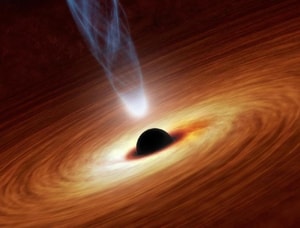Practice Reading & Listening on Black Holes Practice Reading & Listening on Black Holes for IELTS & TOEFL with illustrated flashcards to improve your reading and vocabulary, and a podcast to improve listening transcribed by Mahsa Mohammadi. https://www.youtube.com/watch?v=kOEDG3j1bjs What are black holes? Black holes are among the most fascinating objects in our universe, and also the most mysterious. A black hole is a region in space where the force of gravity is so strong not even light, the fastest known entity in our universe, can escape. The boundary of a black hole is called the event horizon, a point of ...
Home » English Documentaries with Transcript » Practice Reading & Listening on Black Holes for IELTS

Practice Reading & Listening on Black Holes for IELTS
Updated: by Mahsa Mohammadi
Time to Read: 3 minutes | 427 Views | 8 Comments on Practice Reading & Listening on Black Holes for IELTS



So vast the boundaries and so complex the universe is. It is beyond our imagination. Comparing to this amazing complexity we humans have nothing to be boast of. We only are a miniscule molecule of a huge ocean.
Precisely! This documentary on black holes lets us know that the whole solar system is technically a lost particle in the Milky Way galaxy, and even our galaxy is literally a teeny-weeny particle in the entire universe. It shows that the universe is unimaginably immense.
Hello Dr.Hariri .
Actually black holes are big and they come from the stars.
They are so dangerous , even light can not escape from it.
Hi dear Soroosh,
This is the standard way to leave comments, kudos to you!
You’re absolutely right. Black holes are extremely huge and dangerous. They absorb and digest almost everything on their path, even light. In fact, that’s why they’re black because even light cannot get away from black holes.
Hello Dr.Hariri I have a question. In this part ” This includes accretion disks, a disk of particles that …”, what does accretion disk mean?
Hi Armaghan,
Thanks for asking us your questions.
Accretion disk is an astronomical phenomenon in which particles in the space, including gas, dust, etc. start rotating around an object that has a strong gravitational pull, such as a black hole. The rotation is exponential as it gets closer to the center of the gravitational pull or the black hole.
Black holes are among the most fascinating objects in our universe, and also the most mysterious. A black hole is a region in space where the force of gravity is so strong not even light, the fastest known entity in our universe, can escape. The boundary of a black hole is called the event horizon, a point of no return beyond which we truly cannot see. When something crosses the event horizon, it collapses into the black hole’s singularity, an infinitely small, infinitely dense point where space, time, and the laws of physics no longer apply.
Scientists have theorized several different types of black holes, with stellar and supermassive black holes being the most common. Stellar black holes form when massive stars die and collapse. They’re roughly ten to twenty times the mass of our sun, and scattered throughout the universe. There could be millions of these stellar black holes in the Milky Way alone. Supermassive back holes are giants by comparison, measuring millions, even billions of times more massive than our sun. Scientists can only guess how they form, but we do know they exist at the center of just about every large galaxy, including our own. Sagittarius A, the supermassive black hole at the center of the Milky Way, has a mass of roughly four million suns, and has a diameter about the distance between the Earth and our sun.
Because black holes are invisible, the only way for scientists to detect and study them is to observe their effect on nearby matter. This includes accretion disks, a disk of particles that forms when gases and dust fall toward a black hole; and quasars, jets of particles that blast out of super massive black holes.
Black holes remained largely unknown until the 20th century. In 1916, using Einstein’s general theory of relativity, a German physicist named Karl Schwartzchild, calculated that any mass could become a black hole, if it were compressed tightly enough. But it wasn’t until 1971, when theory became reality. Astronomers studying the constellation Cygnus discovered the first black hole.
An untold number of black holes are scattered throughout the universe, constantly warping space and time, altering entire galaxies, and endlessly inspiring both scientist and our collective imagination.
Thank you so much for your perfect transcription of the documentary on black holes.